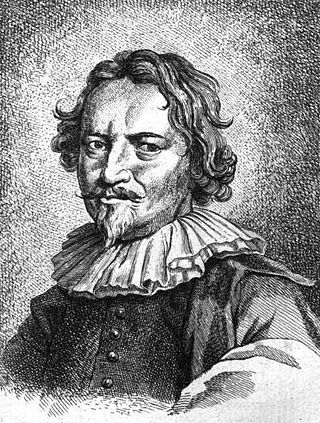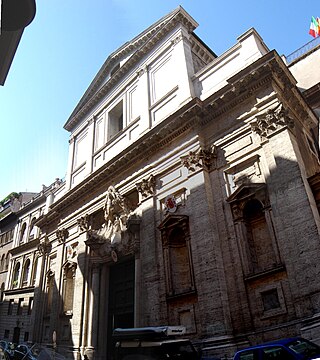
Camillus de Lellis, M.I., was a Roman Catholic priest from Italy who founded the Camillians, a religious order dedicated to the care of the sick. He was beatified by Pope Benedict XIV in the year 1742, and canonized by him four years later in 1746. De Lellis is the patron saint of the sick, hospitals, nurses and physicians. His assistance is also invoked against gambling.

Santa Maria della Vittoria is a Catholic titular minor basilica and Discalced Carmelite conventual church dedicated to Our Lady of Victories in Rome, Italy, famously the home of Gian Lorenzo Bernini‘s masterpiece the Ecstasy of Saint Teresa. The church is in the Rione Sallustiano, on number 98 via XX Settembre, where this street intersects with Largo Santa Susanna. It is located next to the Fountain of Moses and mirrors the Church of Santa Susanna across the Largo. It is about two blocks northwest of the Piazza della Repubblica and Teatro dell'Opera metro station.

Santa Maria sopra Minerva is one of the major churches of the Order of Preachers in Rome, Italy. The church's name derives from the fact that the first Christian church structure on the site was built directly over the ruins or foundations of a temple dedicated to the Egyptian goddess Isis, which had been erroneously ascribed to the Greco-Roman goddess Minerva.

Sant'Eustachio is the 8th rione of Rome, Italy, identified by the initials R. VIII. It is named after the eponymous church and is located within the Municipio I.

The Basilica of Saint Augustine in Camp Martius, commonly known as Basilica of Saint Augustine is a Catholic titular minor basilica in the Campus Martius area of Rome, Italy. Dedicated to Saint Augustine of Hippo it serves as the motherhouse of the Augustinian Friars.

Carlo Fontana (1634/1638–1714) was an Italian architect originating from today's Canton Ticino. He was partly responsible for the classicizing direction taken by Late Baroque Roman architecture.

The Camillians or Clerics Regular, Ministers to the Sick are a Catholic religious order founded in 1582 by St. Camillus de Lellis (1550-1614). A large red cross was chosen by the founder as the distinguishing badge for the members of the Order to wear upon their black cassocks, which was later adopted as the international symbol of medical care. In the past, because of the red cross on their apparel, they were also referred to as the Crociferi. As of 2018, 1080 Camillians serve in 35 countries. They use the postnominal initials of M.I..

Bernardo Antonio Vittone was an Italian architect and writer. He was one of the three most important Baroque architects active in the Piedmont region of Northern Italy; the other two were Filippo Juvarra and Guarino Guarini. The youngest of the three, Vittone was the only one who was born in Piedmont. He achieved a synthesis of the spatial inventiveness of Juvarra and the engineering ingenuity of Guarini, particularly in the design of his churches, the buildings for which he is best known.

The Spanish National Church of Santiago and Montserrat, known as Church of Holy Mary in Monserrat of the Spaniards is a Roman Catholic titulus church and National Church in Rome of Spain, dedicated to the Virgin of Montserrat. It is located in the Rione Regola, at the intersection of alleyway of Via della Barchetta and the narrow Via di Monserrato, with the facade on the latter street, about three blocks northwest of the Palazzo Farnese.
Giuseppe Sardi was an Italian architect active in Rome. He was born at Sant'Angelo in Vado, Marche which was then part of the Papal States. Known primarily for his church of Santa Maria del Rosario in Marino outside Rome, his name has been linked with the design of the façade of the church of Santa Maria Maddalena in Rome although his involvement with this and with some other building projects remains uncertain. He is not to be confused with the Swiss Italian architect, Giuseppe Sardi (1624–1699), who was active in Venice.
Francesco Peparelli was an Italian architect during the 17th century. According to a contemporary historian, Giovanni Baglione, between palaces, castles, churches and convents, Peparelli participated in about seventy construction projects but only about thirty can be attributed to him with certainty.
Emanuele Rodriguez dos Santos was a Portuguese Baroque architect, principally active in Rome. His most important work is the church of SS. Trinità dei Spagnoli in the via Condotti.

Carlo Francesco Bizzaccheri was an Italian architect. He worked in a Baroque and early Rococo style.
Sanctuary San Camillo de Lellis is a church in Milan, Italy.

Santa Maria della Stella is a church located on Via Stella 25 in the quartiere of its name in Naples, Italy.

Santa Maria della Sanità also known as dei Crociferi, is a late-Baroque or Rococo style, Roman Catholic church located on Via Durini #19 in Milan, in the region of Lombardy in Italy.

Santa Maria della Concezione is a church in Rome, located on Piazza Campo Marzio in the Campo Marzio rione. It serves as the national church in Rome for Syriac Catholics.

The Church of Saint Mary of Pity is a Baroque church of Palermo. It is located at the corner of Via Alloro and Via Torremuzza in the quarter of the Kalsa, within the historic centre of Palermo.

The Church of Saint Nympha is a Baroque-Mannerist church of Palermo. The facade rises on Via Maqueda, a block north of the central intersection known as the Quattro Canti, in the quarter of Seralcadi, within the historic centre of Palermo. The church belongs to the Camillians.
San Camillo dei Mercedari, also called San Camillo de Lellis after its titular saint, or San Camillo ai Crociferi after the founding monastic order founded by Camillo de Lellis, the Camillians known popular as the Crociferi, which also gives name to the street which it faces, via Crociferi. Located on #71, is a Roman Catholic church located in the piazza of the same name in Catania, Sicily, southern Italy; the church is one of four major baroque church-monasteries on this street, the others being San Francesco Borgia (Jesuit), San Giuliano, and San Benedetto.


















